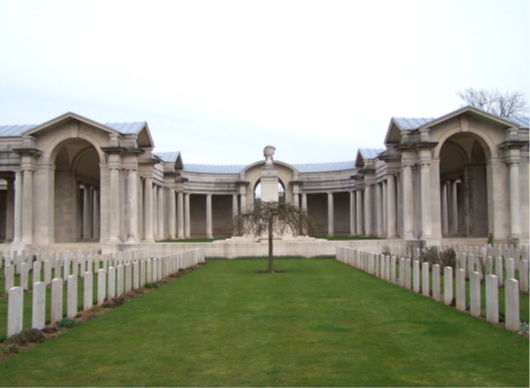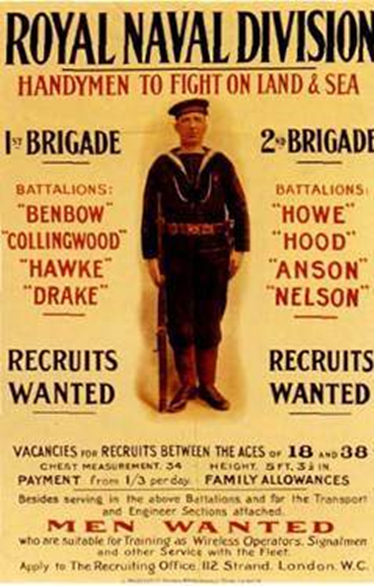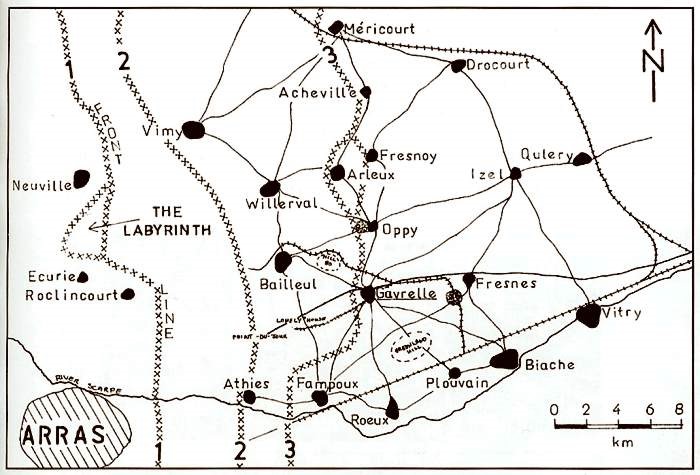EDWARD DIVALL
Private, 46126, 7th Battalion, The Royal Fusiliers, 63rd Royal Naval Division
Died 29 April 1917 near Arras, France, aged 41
No known grave. Listed on the Arras Memorial, Bay 3

The Arras Memorial
(Click to enlarge)
Edward Divall was born in Hartfield in 1876, the son of Thomas and Hannah Divall (née Davies), of Hurstland Cottages, Hartfield. In 1881 he was living at Chuck Hatch with his parents and brother. His father was listed as a 'road man'. His grandfather was a brickmaker. By 1891 he had moved to Hartfield with his family, and he and his father were listed as general labourers. He had two sisters and two brothers. In the 1901 census he was recorded as a boarder, aged 24, in Ridgewood, Uckfield, Sussex, where his occupation is given as brickmaker (Ridgewood was the centre of brickmaking in Uckfield).
He was married to Ellen Divall (née Mitchell, b.1880), of 37, New Road, Ridgewood, and they had a daughter Sophia Grace (b.1906). Edward's pre-war occupation was as a file presser at the Sussex Pottery, Brick and Tile Works, Uckfield.
The Royal Naval Division

Recruiting poster from early in the War
(Click to enlarge)
Originating in the Royal Navy, and manned by sailors and marines, the Royal Naval Division was incorporated into the Army in 1916. Illustrious figures served in it, such as the poet Rupert Brooke, Bernard Freyberg (the future governor-general of New Zealand) and the author and later parliamentarian Alan Herbert, but also Edwin Dyett, later executed for cowardice. At the declaration of the war on 4 August 1914, there was a surplus of some 20-30,000 men of the reserves of the Royal Navy who would not find jobs on any ship of war. It was recognised that this was sufficient to form two naval brigades and a brigade of marines for operations on land as, at the end of the Division's involvement in the Gallipoli campaign, very few men with sea service remained. The Division was transferred from the authority of the Admiralty to the War Office on 29 April 1916 and was redesignated as the 63rd (Royal Naval) Division on 19 July 1916.
The Arras Offensive and the Battle for Gavrelle

Map of the Arras Offensive
(Click to enlarge)
The Division moved to France, arriving at Marseilles on 12-23 May 1916, after which it remained on the Western Front for the rest of the war. There it took part in the Battle of the Ancre, a phase of the Battles of the Somme 1916 (13-18 November 1916), the Operations on the Ancre (January-March 1917), the Second Battle of the Scarpe (23-24 April 1917), a phase of the Arras offensive, and a further phase of this offensive in which the Division captured Gavrelle in the Battle of Arleux (28-29 April 1917). It is likely that Edward Divall was involved in these battles.
The Arras offensive of 9 April-16 June 1917 became known primarily for the conquest of Vimy Ridge by the Canadians, who placed their national memorial there. The British launched their offensive on 9 April 1917. The Third Army, led by General Edmund Allenby, was under orders to proceed to the north and south of the river Scarpe. The 4th British and 9th Scottish Divisions attack to the north of the river. The first day went well: the Germans were surprised and the aims were achieved. Making some three miles of progress in one day was unheard of since the battle of the Somme. The front moved north of the Scarpe to beyond the line between Athies and Vimy (see map, line 2), and even the village of Fampoux was reached. Progress after that was appreciably more difficult on account of German action. In mid-April an attack on the village of Roeux, situated on the river, failed and Douglas Haig ordered a break in operations.
On 16 April, meanwhile, the French had launched their attack at the Chemin des Dames, which was a failure from day one. The French demanded however that the British continue their offensive. And thus, fighting carried on. The Royal Naval Division was ordered to take Gavrelle and breach the third German defensive line. The attack on Gavrelle commenced on 23 April and was carried out by the 189th and 190th brigades. At 4.45am Nelson and Drake battalions went 'over the top' under cover of an artillery barrage. The first line of German trenches was quickly taken, and an hour later the attack was ceased at the edge of the village. The artillery barrage was relocated across the village, which was reduced to rubble. Other battalions from the brigade were moved forward. House-to-house fighting led to the taking of Gavrelle, at the cost of 1,500 casualties.
On the next day the Germans launched a counter-offensive to re-take Gavrelle, starting with an intense bombardment. This was beaten off, and on 26 April, the attacking battalions were relieved. In the Official History of the Great War the following is printed with regard to the fighting at Gavrelle between 23 and 25 April:
'Full justice has not been done to the achievement of the 63rd Division, because the details of the street fighting in which it showed skill and determination are to intricate for description. The division had taken 479 prisoners and in defeating the counterattacks had obviously inflicted heavy loss upon the enemy.'
The relief troops had to continue the British attack towards the windmill, a reinforced German position north-east of the village. This task was allocated to the marines and the Anson battalion of the 188th Brigade, who had not been deployed on 23 April. The attack started at 4.25am. The second battalion of marines succeeded in taking the windmill, and held it as an enclave in German-held territory. That was the only British gain, because after a day of bloody fighting, the situation was basically unchanged from the start. That did not change until the troops of 31st Division relieved them in the night of 30 April.

Artist's impression of the fight for the windmill at Gavrelle(Click to enlarge)
(Source: War Illustrated, 17 July 1917)
The Royal Naval Division suffered 3,000 casualties in the fighting at Gavrelle. In particular, the losses of the Royal Marines Light Infantry were severe, with 850 casualties and many dead, including the commanding officer of the first battalion of marines, lieutenant-colonel Cartwright.
Private Edward Divall died on 29 April 1917 near Arras, aged 41. He has no known grave and is listed on the Arras Memorial, Bay 3. He is listed on the war memorials in Hartfield and Uckfield.
Carol O'Driscoll
31 January 2017

